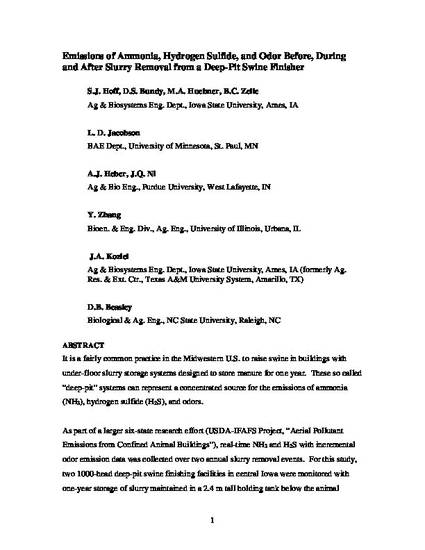
It is a common practice in the midwestern United States to raise swine in buildings with under-floor slurry storage systems designed to store manure for up to one year. These so-called “deep-pit” systems are a concentrated source for the emissions of ammonia (NH3), hydrogen sulfide (H2S), and odors. As part of a larger six-state research effort (U.S. Department of Agriculture-Initiative for Future Agriculture and Food Systems Project, “Aerial Pollutant Emissions from Confined Animal Buildings”), real-time NH3 and H2S with incremental odor emission data were collected for two annual slurry removal events. For this study, two 1000-head deep-pit swine finishing facilities in central Iowa were monitored with one-year storage of slurry maintained in a 2.4 m-deep concrete pit (or holding tank) below the animal-occupied zone. Results show that the H2S emission, measured during four independent slurry removal events over two years, increased by an average of 61.9 times relative to the before-removal H2S emission levels. This increase persisted during the agitation process of the slurry that on average occurred over an 8-hr time period. At the conclusion of slurry agitation, the H2S emission decreased by an average of 10.4 times the before-removal emission level. NH3 emission during agitation increased by an average of 4.6 times the before-removal emission level and increased by an average of 1.5 times the before-removal emission level after slurry removal was completed. Odor emission increased by a factor of 3.4 times the before-removal odor emission level and decreased after the slurry-removal event by a factor of 5.6 times the before-removal emission level. The results indicate that maintaining an adequate barn ventilation rate regardless of animal comfort demand is essential to keeping gas levels inside the barn below hazardous levels.
Available at: http://works.bepress.com/jacek_koziel/292/

This is the peer-reviewed version of the following article: Hoff, Steven J., Dwaine S. Bundy, Minda A. Nelson, Brian C. Zelle, Larry D. Jacobson, Albert J. Heber, Jinqin Ni, Yuanhui Zhang, Jacek A. Koziel, and David B. Beasley. "Emissions of ammonia, hydrogen sulfide, and odor before, during, and after slurry removal from a deep-pit swine finisher." Journal of the Air & Waste Management Association 56, no. 5 (2006): 581-590, which has been published in final form at 10.1080/10473289.2006.10464472. This article may be used for non-commercial purposes in accordance with Wiley Terms and Conditions for Self-Archiving.